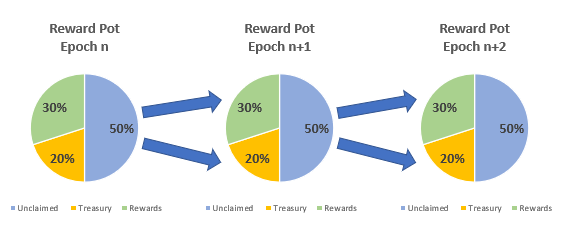Discussing blockchain parameters is not the most popular or fun thing to do, but it affects all the users of Cardano equally. In this article I will try to explain what the treasury tax, or more technically what the Tau parameter is, why it is important and the reason behind Earncoinpool’s proposal to decrease it.
What is the Tau parameter?
Tau or treasuryCut is one of many parameters that govern the Cardano blockchain. These parameters are classified by category and they can be network, economic, technical or governance. There are also updatable and non-updatable parameters, these last ones are the most critical in terms of security and basic functioning of the blockchain and can only be changed with a hard fork.
The Tau parameter is the one that determines the proportion of total rewards allocated to treasury each epoch before the remaining rewards are distributed to pools. At this moment the Tau parameter is set to 0.2 or 20%, this means that before every epoch reward distribution happens, 20% of the total goes to the treasury. At the time of writing this article the treasury holds 1.53B $ADA with a market valuation of $695,886,944 USD.

Proposal to change it
Cardano community member and stake pool operator Earncoinpool has created a PCP or Parameter Change Proposal to lower the treasury tax. The proposal was created in October 2023 and provides the rationale behind this proposed change. The average growth of the treasury between epochs 431 to 443 was approximately 5 Million ADA per Epoch. This means that approximately 30 Million ADA is added to the Treasury each month. Earcoinpool proposes to lower the tax to the original intended value of 5%. As pointed out in the proposal, at the beginning IOG researchers evaluated and had considered setting the tau parameter to 5%. However, before the Shelley mainnet launch they determined the rate should be set to 20%.
The reasoning behind this decision is provided by Cardano forum user Feqifei in this post. Before the launch of Shelley, IOG researchers were analyzing the correct set of parameters that would govern the blockchain once the block production was shifted to the community. They were mainly discussing a0 poolPledgeInfluence, k stakePoolTargetNum and d parameters. This is the time when they also made the mistake of setting a0 or pledge influence to a really low value which is almost the same as if it was zero. But they were also analyzing the right mix of tau, the parameter that sets the treasury taxation applied to the epoch reward pot, and rho, the expansion rate of the circulating supply. Because the pledge influence was set so low, the amount of unclaimed rewards would be much higher than expected. The average amount of pledge was going to be much lower than anticipated because there was no economic incentive to set a high pledge as researchers were expecting originally. In order to mitigate an excessive transfer of ADA from the reserve to the treasury, they decided to update these rules. A few weeks before Shelley went live, the treasury tax was changed from 5% to 20% and the destination of the unclaimed rewards was changed to the reserve pot, for the benefit of delegates and pool operators.
However, this change led to an unforeseeable double taxation. Because the treasury tax applies before the reward calculation and distribution, resulting in the whole epoch reward pot being taxed first. This means that all the ADA in the reserve pot will be affected by double taxation sooner or later, because the 50% of unclaimed rewards that are taxed and then sent back to the reserve will be taxed again, at the moment when it’s used to pay delegates and stake pool operators.

Why should you care?
You may be asking yourself why you should care about some obscure blockchain parameter with a weird Greek letter name. The reason why you should care is because if you are a Cardano user, every time you send a transaction you pay 20% to the treasury. If you are delegating your ADA to secure the network, your rewards are being double taxed by 40%.
On the other hand, the only purpose of the treasury is to fund Project Catalyst, which if you read my previous articles Edinburgh Decentralization Index, CIP-1694 “Temperature Check”: Vox Populi, Vox Dei? And Why Governance on Cardano Will Fail you know that is a small handful of insiders who actually decide the outcome of which projects get funded. A quid pro quo among wealthy whales and “OGs”. So it’s basically the shrimps (< ₳100), fish (₳100 – ₳1k), seals (₳1k – ₳5k), dolphins (₳5k – ₳10k) and sharks (₳10k – ₳50k) that are funding the whales’ “projects” on Catalyst.
But perhaps the reason you will care most about, if you delegate ADA and secure the network, is the decreased staking rewards. After the Shelley hard fork when stake pools and staking were introduced on mainnet, the annualized return on stake was around 6%. Since every epoch in Cardano is similar to a small bitcoin halving, the amount of rewards being distributed decreases with time. Now almost 46 months later, the majority of stake pools has an annualized return between 2.63% and 3.16%. This value will continue decreasing which presents a security risk for the network.

Although the majority of DeFi protocols in Cardano now have implemented some kind of mechanism which continues to stake the ADA deposited on the dApp, the risk of the end user deciding not to stake their ADA because the rewards are “too low” will continue to increase. This is a serious concern in a proof-of-stake blockchain which remains secure as long as there are enough tokens participating in the consensus.
Another issue is the real reward rate, which is calculated by subtracting the inflation rate (new ADA entering circulation) from the staking reward. Staking Rewards calculates this metric at 0.52% currently, with an implied reward rate of 2.99% and an inflation rate of 2.47%.

Decreasing the treasury tax to a real rate of 5%, as originally intended, would make transactions cheaper (important for when ADAUSD reaches a new all time high), it would increase rewards for delegates and it would increase the real reward rate, making it more attractive to secure the network.
Conversation with Earncoinpool
Q1: Why did you decide to create the PCP for reducing the treasury tax back in October 2023?
A1: There was a lot of talk amongst the Cardano community about how the rewards were reducing and what we could do to possibly increase them. In my discussion with other pool members of the xSPO Alliance we noticed that within the community there was a lack of understanding about the treasury and how it grows. We noticed that most of the community seemed unaware that before rewards are calculated and distributed through the protocol, there is a percentage that is taken out and put into the treasury. This percentage is assessed for the total rewards pot which averages about 26 million. Through my research I realized that the effective tax/growth rate of the Treasury was actually closer to 33% instead of the stated 20%. Further I noticed that roughly each epoch about 5 million was added to the treasury while roughly 10 million ADA was distributed as rewards to delegators and SPOs. While the remaining 11 million returned to the treasury as unclaimed rewards
https://forum.cardano.org/t/pcp-treasurytax-tau-parameter-earncoinpool/123245/3?u=earncoinpool
Q2: Cardano forum user Feqifei raised the issue of double taxation much earlier in October 2020. Why do you think this problem has gone unnoticed for so long?
A2: I’m not sure. I think the issue might be that the process to get these highly technical issues addressed is through the Cardano forum and overall It’s hard to draw awareness to such technical issues. So we often see if the founding entities or some big influencer doesn’t take it up, it gets little attention, even if it is important. So we as the community have to do our part and spread the word and generate awareness for important topics.
Q3: Joaquín López, the secretary of the parameters committee, recently responded on the PCP that the committee has decided to defer the proposal. Why do you think there is no interest in decreasing the treasury tax?
A3: I’m not sure that there is no interest in decreasing the treasury tax/growth rate. I think the committee was just saying they were currently at capacity and were holding off on new PCPs until the next window.
Q4: On a recent X/Twitter post you mentioned that one year ago the poll on K and minPoolCost went live and the majority chose to raise K to 1,000 and lower minPoolCost to 170. However only minPoolCost was changed by the parameter committee. What do you make of this?
A4: Well we were told the K=1,000 was still on the table and that they were not ignoring the community vote and that they just wanted to monitor the reduction of pool min cost. We were also told we need to submit a PCP to get it addressed.
So that is what I did with the first community submitted PCP. I think enough time has passed that I’m confident that the parameters committee will take up the K-PCP in the next window. I expect they will recommend K=1,000 once the K-PCP is taken up in the next window. So I’m hopeful we will see progress soon.
Q5: Given the fact that the parameter committee continues to defer these two PCP you created to address issues recognized by the entire community. Do you think the committee is following the will of the community or their own self interests?
A5: They stated that the PCPs that they took up first were more urgent to take up and I take them at their word. That said enough time has passed and I assume most of the research work around raising K was already done back when pool min cost was adjusted, so that any further delay would raise questions. I believe enough time has passed (one year since the on-chain poll) that the committee now owes the community a recommendation.
I would also say that I think the community needs to speak up a bit more over these technical issues. As you stated in your question you believe that these issues are recognized by the entire community. While I tend to agree with that assessment, some will argue that my PCPs on the Cardano forum have low engagement as a reason to not take them up. So I would urge the community to read my PCPs, give them a like and/or join the conversation. Please spread the word throughout the Cardano community and let’s keep the conversations going. Thank you! – Rich (Earn Coin Pool)
K-PCP position to resubmit – https://forum.cardano.org/t/pcp-k-parameter-earncoinpool/122701/98?u=earncoinpool
Treasury Tax Tau PCP – https://forum.cardano.org/t/pcp-treasurytax-tau-parameter-earncoinpool/123245?u=earncoinpool










